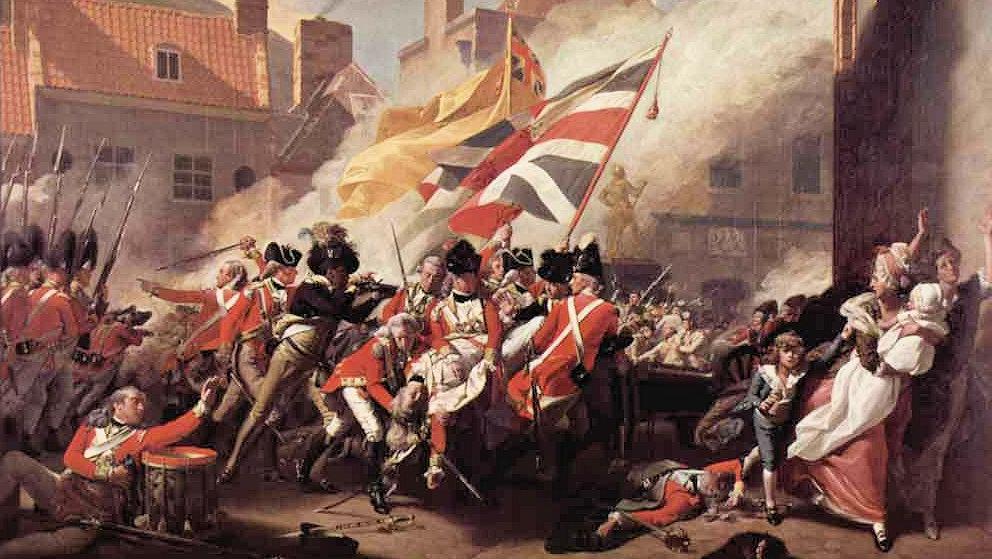
Exercise and learn about Jersey’s history – Battle of Jersey commemorative walk
Plans are in hand for a Battle of Jersey commemorative walk to take place in January 2022.
After leading the popular annual event for over ten years, organiser Frank Falle is handing over responsibilities to fellow local historian Ian Ronayne.
The walk, marking the French attempt to capture the Island in January 1781, first took place following an initiative by Mr Falle and support from St Helier’s Constable Simon Crowcroft.
Both were keen to raise awareness of this important historic event, which culminated in a bloody battle and death of Major Francis Peirson in the Royal Square.
Mr Falle particularly wanted to highlight the important part played by Jersey’s Militia, the Island’s ancient volunteer defence force, which fought alongside regular soldiers to win victory in this last battle on British soil and secure Jersey for future generations.
“Had it not been for the determination of men like Major Peirson and bravery of both British and local troops during the Battle of Jersey our history may have been very different,” Mr Falle said. “As such, it is a story I have enjoyed recalling through words, walking and commemoration for several years now.
“Having reached a certain age, however, it feels the right time to handover responsibilities for organising and leading the walk. I am pleased Ian has agreed to take it on, and I am sure he will continue doing this important event justice.”
Ian Ronayne, who is a local historian, author and member of the Jersey Tourist Guides Association, will lead the planned 2022 walk. It will take place on Saturday 8th January, commencing at St Mary’s Parish Hall (next to St Mary’s Primary School) and culminating in the Royal Square.
“Frank established the principle of starting from a different location each year, based mainly on muster points used by the Jersey Militia back in 1781,” Mr Ronayne explained. “Given this year will mark something of a new start for the Battle of Jersey walk, we decided to commence near St Mary’s Church, where men from the Militia’s 1st (North-West) Regiment would have gathered. I am looking forward to telling their story and that of all who took part in the battle, along with explaining the historic role and contribution of Jersey’s Militia.
“I am also hugely grateful to Frank – not only for asking me to take over leading the walks, which is a great honour, but also for his commitment to this cause over the years. Having regularly enjoyed Battle of Jersey walks in the past, it is important to me and I am sure many others that they continue for both historic and social purposes.”
Walkers are asked to gather in front of St Mary’s Parish Hall at 8.45am to hear a talk on the battle and history of the Jersey Militia before setting-off for St Helier at 9am sharp.
There is no charge for joining, but walkers are encouraged to donate to the Gurkha Welfare Trust, a charity strongly supported by Mr Falle. The route follows public roads and designated pathways, with anyone wanting to take part prepared to walk up and down hills on the way to town.
The usual culminating point of the commemoration is a parade and musketry display by the 1781 Jersey Militia in the Royal Square, St Helier.
The Battle of Jersey commemorative walks typically start in a different location each year, with each chosen to represent a muster point for Jersey’s Militia in 1781. In the past these have included St Martin’s Church, Grouville Church, St Peter’s Church and St Lawrence Church. The walk has also followed the route taken by French invaders under Baron de Rullecourt, starting at his landing point at La Rocque.
About the Battle of Jersey
- The French invasion in 1781 was an attempt to capture and eliminate the Island, which was both a threatening British outpost and naval base for privateers. These officially sanctioned vessels were raiding French shipping along the coast of France, in the Channel and even off America where the French were engaged in the American Revolutionary War.
- The invasion was led by the Baron Philippe de Rullecourt, who had been promised a reward by the French King but ended up dying of wounds sustained during subsequent fighting in the Royal Square.
- De Rullecourt chose to invade in mid-winter, a time he hoped Jersey’s defences would be least prepared. He also selected La Rocque as a landing point, believing that the rocky shoreline there might be less protected than the Island’s sandy beaches.
- After a stealthy march to St Helier, the French succeeded in capturing the Island’s Lieutenant Governor, Major Moses Corbet, coercing him to surrender Jersey to what he was told was a superior force.
- British forces ignored the surrender order, however, mustering under the command of 24-year-old Major Francis Peirson on Westmount. From there, he led a combined force of regular soldiers and Jersey Militiamen into town to confront De Rullecourt’s French troops in the Royal Square.
- The more numerous British quickly overcame their enemy, although Major Peirson died during the attack. A second French force at La Rocque was similarly defeated.
- The Jersey Militia that took part in the fighting was an ancient force raised several centuries earlier to defend the Island from persistent French raids and invasions. It remained in existence until the Second World War, after which the force was disbanded. The Jersey Field Squadron, formed in 1988, subsequently assumed many Militia traditions.
Main image courtesy of Jerripedia.








